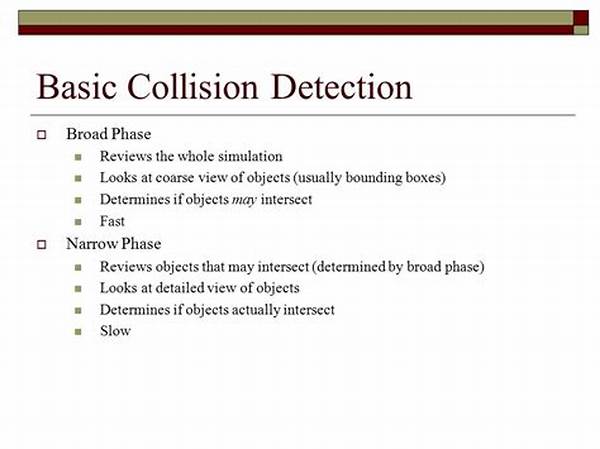Hey there, fellow tech enthusiasts! Today, we’re diving into the fascinating world of collision detection, specifically focusing on those crucial broad-phase collision detection strategies. If you’ve ever wondered how video games or simulations manage to handle millions of objects without crashing and glitching all over the place, you’re in the right spot. Let’s explore this techy yet thrilling topic in a way that’s easy to digest. So, grab a cup of coffee, sit back, and let’s unravel the magic behind the algorithms that keep our virtual worlds in check.
Read Now : **improving Customer Retention Rates**
Understanding the Basics of Broad-Phase Collision Detection Strategies
Now, let’s break it down. Broad-phase collision detection strategies are all about efficiency. In a virtual environment where a bazillion objects might be floating around, checking every single one for collisions could slow things down a lot. That’s where these strategies come in. They act as a sort of preliminary filter, quickly ruling out pairs of objects that couldn’t possibly collide based on their positions and dimensions.
The real magic of broad-phase collision detection strategies lies in their ability to sift through large groups of objects efficiently. Imagine a crowded dance floor with people moving around. Broad-phase is like spotting potential dance partners in the crowd by focusing on a few quick insights: the dancer’s location, their direction, and their rhythm. Instead of closely observing each pair of dancers, we quickly eliminate those who are too far or not dancing at all. It’s all about saving time and resources, allowing the game or simulation to focus on the actual potential collisions.
In essence, these strategies help in maintaining smooth and responsive gameplay by offloading the burden of identifying possible collision pairs from a humongous scene. And trust me, when executed well, they ensure that your game or app runs as smooth as butter, keeping users immersed and happy. So, next time you’re playing your favorite game, remember the unsung heroes—the broad-phase collision detection strategies—working tirelessly behind the scenes.
Key Techniques in Broad-Phase Collision Detection Strategies
Let’s chat about the techniques! Here are five key tricks up the sleeve of broad-phase collision detection strategies.
1. Spatial Partitioning: This method involves dividing the game world into smaller sections, each being checked separately for collisions. It’s like organizing your room to avoid stepping on Legos. Perfectly satisfying!
2. Bounding Volume Hierarchies (BVH): Think of this as a hierarchy of boxes. These boxes encapsulate groups of objects, quickly ruling out irrelevant ones. Handy for big worlds with lots of objects!
3. Uniform Grid: Imagine placing a grid over your game world. Only the objects within the same grid cell are checked for collision, much like checking mail only when it arrives in the same zip code.
4. Sweep and Prune: With this, objects are sorted along an axis, and only overlapping objects are checked further. It’s like lining up track cars and seeing which ones are in danger of crash.
5. Quadtrees and Octrees: These data structures break down the space into nested, uniform divisions, ideal for dealing with areas of varying object density. Think of it as neatly stacking your books according to size and genre on your shelves.
Broad-Phase Collision Detection Strategies in Action
Alright, let’s see how these broad-phase collision detection strategies play out in real-world scenarios. Picture this: a bustling city simulation with cars, pedestrians, and flocks of pigeons. All these moving elements need constant monitoring to prevent chaotic overlaps and mid-air bumps.
By employing spatial partitioning, the simulation divides the city into grids, acting like invisible block streets. Cars drive within these blocks, and only those sharing the same block are considered for collision detection. This cuts down on computational work, saving time and ensuring that the simulation runs smoothly as cars cruise through the pixel city.
In the realm of space exploration games, developers often leverage quadtrees or octrees. These facilitate handling three-dimensional space, crucial for rendering galaxies filled with starships, asteroids, and satellites. By dividing the cosmic space into smaller cubes (or squares in 2D), games can fluidly handle collision checks, allowing for epic interstellar battles without misshaped orbits and treacherous crashes. Broad-phase collision detection strategies truly bring order to the chaos of virtual realms!
Deep Dive into Broad-Phase Collision Detection Strategies
The broad-phase collision detection strategies are the unsung heroes behind seamless gaming. They ensure minimal lag and optimal performance amidst a multitude of moving parts without a sweat.
1. Spatial Partitioning quickly eliminates distant objects. Super handy in complex scenes.
2. Bounding Volume Hierarchies (BVH) compress the world into manageable chunks, shaving off unnecessary checks.
3. Uniform Grid provides tiny sections to evaluate, smoothing performance.
4. Sweep and Prune efficiently compares object positions and motions.
5. Quadtrees and Octrees masterfully manage the visual space.
Read Now : Interactive Collision Response Systems
6. Creative implementations of these techniques unleash endless possibilities in gaming, from epic battles to serene simulations.
7. Algorithms constantly calculate just enough to keep those engaging graphics flowing.
8. By simplifying collision checks, they drastically reduce processing power.
9. These strategies prioritize smooth user experience without breaking a sweat.
10. Next time you’re immersed in stunning visuals and fluid gameplay, remember that broad-phase collision detection strategies are the silent guardians ensuring thrilling adventures stay seamless.
Exploring Advanced Applications of Broad-Phase Collision Detection Strategies
Welcome back! Now, let’s venture into the more sophisticated uses of broad-phase collision detection strategies. If you’re a game developer or an enthusiastic coder, you might be wondering how to harness these strategies beyond the gaming realm.
For instance, in virtual reality simulations, broad-phase strategies serve as the underlying mechanism maintaining real-time interactions. They ensure that virtual objects don’t bizarrely phase through one another, making VR experiences fluid and immersive. Imagine moving through a VR space station without bumping into invisible obstacles. Magic? Nope! Just brilliant collision detection at work.
Additionally, these strategies are pivotal in robotics where digital twins monitor the movement and interaction of robot parts in factory settings. By preemptively eliminating improbable collision pairs, broad-phase collision detection strategies optimize the real-time efficiency of assembly lines, keeping operations running smoothly and safely.
In summary, through smart use of broad-phase strategies, developers can ensure their applications not only perform efficiently but are also resilient to scale as they encompass more interactive elements. Whether in VR universes or industrial sectors, collision detection continues to redefine the capabilities of our digital interactions.
Insights into Broad-Phase Collision Detection Strategies
Hello again, tech buffs! It’s time to wrap up our exploration with some insightful takeaways on broad-phase collision detection strategies. Encapsulating its brilliance, here are a few reasons why these strategies are the backbone of any interactive digital experience.
Broad-phase collision detection strategies excel at efficiently managing virtual worlds teeming with active objects. They guarantee that your applications and games exhibit stunning visuals and unyielding responsiveness. Imagine your favorite RPG game – those seamless battles, where countless characters and spells fly around without a moment of lag? That’s these strategies working overtime, even during the most chaotic in-game moments.
These strategies are powerful tools for developers aiming to optimize computational resources. By strategically narrowing down the scope of detailed collision checks, developers can focus on refining other essential features, like visuals and AI interactions. So, by choosing the right broad-phase method, you’ll have a well-oiled machine that looks and feels realistic.
In conclusion, broad-phase collision detection strategies are the unsung champions of high-performing, sophisticated digital experiences. The next time you hit play on your go-to game, remember that it’s the tech behind the screen making everything wonderfully possible. Cheers to innovation and the endless possibilities that come with it!
Summary of Broad-Phase Collision Detection Strategies
Alright, friends, let’s tie it all together. We’ve delved into the fascinating mechanics behind broad-phase collision detection strategies, those crucial tools that breathe life into our virtual landscapes. They’re the masters of sorting, filtering, and optimizing—a digital gatekeeper that ensures only relevant interactions are examined in detail.
In essence, broad-phase collision detection strategies tackle performance bottlenecks head-on by intelligently managing interactions between virtual entities. They delicately balance between precision and performance, meaning your applications can run more smoothly even when packed with many objects. Game developers, virtual reality creators, and even industrial software engineers rely on these strategies to achieve optimal efficiency without compromising quality.
Ultimately, these strategies are a testament to the remarkable ingenuity within computer science. By employing inventive algorithms, they empower us to create immersive, interactive experiences seamlessly. As you embark on tech projects or play through captivating digital realms, remember the silent but pivotal role broad-phase collision detection strategies play in crafting the unmatched experiences we enjoy today. Here’s to more groundbreaking innovations, fueled by brilliant collision detection magic!





